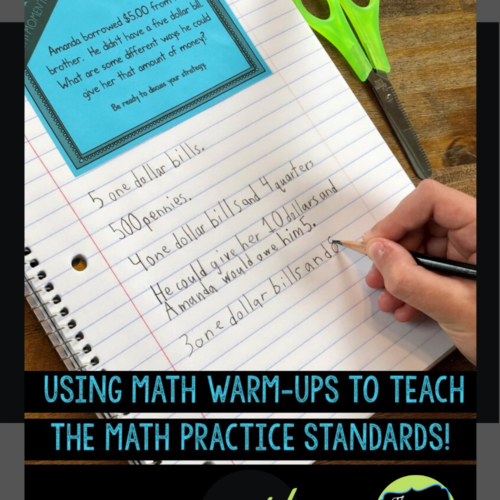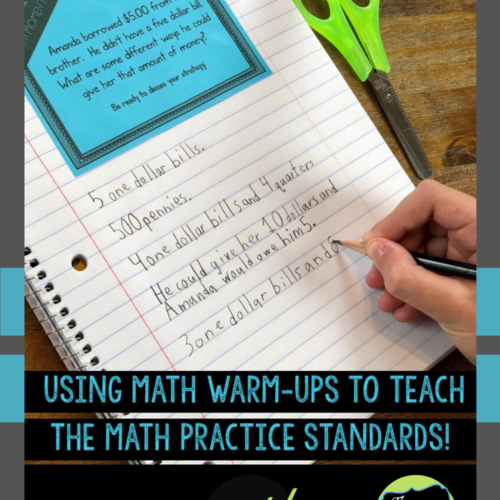








The first ten minutes of your math lesson will set the tone for the rest of the class. Students must be “activated” and engaged so that they are ready to learn. Using high-level math warm-ups at the start of each lesson will accomplish this goal.
My Math Warm-Up Routine
- I have my problem for the day ready–either ready to project, ready to glue into notebooks, or ready to send via Google Classroom. I mix these up to keep things interesting.
- Students get just a few minutes to work, and it varies by problem. Some students will finish, while others may not. I work hard to build the culture so students understand that the solution is secondary to the process.
- After we have enough math to talk about, it’s math talk time! Sometimes I have students turn and talk in their desk groups or with a partner, sometimes I have a few students share under the document camera, and sometimes I have whole-class discussions about the problem and solution strategies.
- If I feel it’s important, I may jump in and do some clarification of misconceptions or do some reteaching.
- I summarize key takeaways from the warm-up before we head into our main math work for the day!
Why these warm-ups work!
- They are short, engaging, and different from what they see in the rest of math class.
- This process builds math community and culture and helps create a climate of risk-taking and collaboration.
- The problems address all 4th grade math concepts in different formats. The math gets more sophisticated as the year progresses.
- Because they are not tied to any set curriculum sequence, they serve as an informal “spiral review”, perfect to keep addressing skills all year long.
- Students start math class with real thinking rather than procedures.
- Transition times are reduced and on-task behavior increases.
- Students feel good about math and improve their skills!
Need this for your classroom? CLICK BELOW to check it out!
————————————————————————————-
Want to learn a bit more? READ ON!
————————————————————————————-
This resource was “born” to give me a ready-to-use task to get students thinking and talking about math the second they walk in! I always end up scrambling with my planning, and I wanted to have my entire year of warm-ups ready to roll and to know that I was addressing all fourth-grade math standards.
What did I include to help you use these math warm-ups?
- 36 weeks (5 problems per week) of math warm-ups that are perfect to get students thinking, talking, and thinking about all fourth-grade standards
- Standards alignment information to help you see what concepts are covered in each of the four sets of problems
- Suggestions for use, teaching tips, and solutions strategies
- Problems presented in multiple formats for ease of use: Full page slides to project or send digitally and quarter-page slides to print and use in math notebooks
- Accountable math talk suggestions and posters to display
- Guidance on the Standards for Mathematical Practice and how they relate to these math warm-ups (see below for this information if you are curious!)
- All directions needed to use this either in print format or digitally!

Building Math Warm-Up Routines and Habits
I like to keep things novel, so I don’t use the same routines every day for warm-ups. Here are few ideas and “tips” for keeping things fresh and meaningful.
- Project a problem and have students work collaboratively to solve it.
- Pass out the quarter sheet problems to glue into math spirals, work independently, then collaborate to discuss solutions.
- Send a problem digitally via Google Classroom, have students work individually, and then compare solutions.
- No matter what, keep the amount of time for the problem brief and always allow time for discussion.
- Keep students focused on having a growth mindset. Some days they may not solve the problem—or completely solve it. They can still learn from the discussion.
- Encourage students to at least “get started”…this is a part of the standard “Make sense of problems and persevere”.
- Work to create a climate of creativity with problem-solving, and help students realize that there are often multiple solutions and many ways to achieve the same result!
The Importance of the Standards for Mathematical Process
We so often put more emphasis on the CONTENT standards than the PROCESS standards, so I wanted my math warm-ups to really tackle the process standards. Often people ask me how many of my lessons do this, so I thought I’d give you world’s shortest overview of these standards and how these warm-ups help!
Standards 1 and 6: The “make sense of problems and persevere” and “attend to precision” apply to all problems. We want students to find entry points, to be able to draw from strategies in their toolboxes and to be able to work accurately and precisely. This is true for all problems in this collection.
Standards 2 and 3: These standards are all about reasoning, explaining thinking, defending ideas, supporting with evidence, and representing math with concrete symbols and representations. This is why we want students talking about these problems, discussing solutions, critiquing their own ideas and the ideas of others, and representing their thinking in their notebooks or digitally. When they share their ideas with the class, you have a golden opportunity to teach about accountable talk strategies, how to explain clearly, represent ideas so others can understand them, and so on.
Standards 4 and 5: These standards are all about using resources and tools to help solve problems and support arguments. Whether it be to use a diagram to help find a solution, use math “tools” such as rulers or manipulatives, or using models such as numbers lines, students can use these to both SOLVE problems and explain solutions.
Standards 7 and 8: These standards are all about finding the patterns in math and understanding the properties. Many of the problems I present do exactly this—they ask students to look for patterns and find ways to solve problems using shortcuts and other math they know!
Math Warm-Ups: TEACHING HINTS:
- These warm-ups will come in a variety of “shapes and sizes”. Some will be familiar like a word problem, and some are totally different than you would find in a math series.
- Remember…no matter WHAT the task, the goal of these warm-ups is to get students thinking and talking about math, using a variety of strategies, and thinking outside the box.
- So if the warm-up is a word problem, we want to hear a variety of different solution strategies. We want to see how students organized their work. We want to identify tricky parts and misconceptions. The whole point of these is to dig deeply into math, not just find an answer.
- Many of the tasks are open-ended with multiple solutions. Make sure that understanding is a part of your instruction so students learn to look for this and challenge themselves to find different ways to solve problems! If we can get them to realize that the solution is only part of the deal and that the process is way more important, it helps build the culture for a great math class!
- Remember the intent of these warm-ups is to get students digging into math from the first minutes of class, to be working on grade-appropriate math concepts, and to be constantly applying the math practice standards and great math talk. We want engaged, “activated” students who love to tackle challenges and can show perseverance and math stamina!
Ready to get started?
Want to try a week for free? Just click RIGHT HERE or the image below.
Or just grab your math warm-ups bundle now!
AND NOW….. THIRD GRADE MATH WARM UPS ARE READY!
And now fifth grade warm ups are ready for you!
Rather pin this for later?
COMING SOON! Grade 2!
Want to read even more about math warm-ups?
Here is a blog post about keeping your use of math warm-ups fresh and exciting!
And here is another one about how using math warm-ups utilizes educational best practices.














